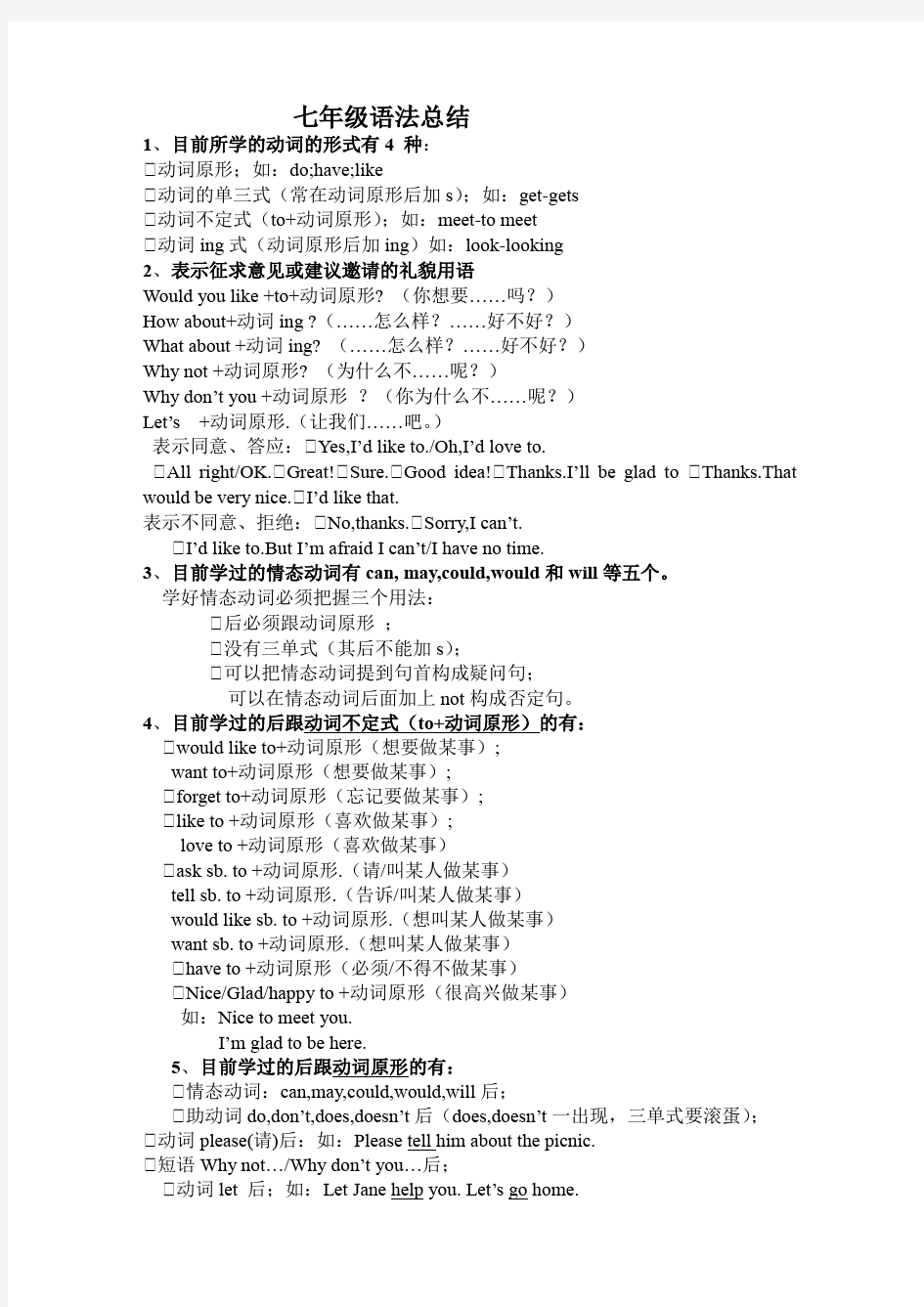- 1、下载文档前请自行甄别文档内容的完整性,平台不提供额外的编辑、内容补充、找答案等附加服务。
- 2、"仅部分预览"的文档,不可在线预览部分如存在完整性等问题,可反馈申请退款(可完整预览的文档不适用该条件!)。
- 3、如文档侵犯您的权益,请联系客服反馈,我们会尽快为您处理(人工客服工作时间:9:00-18:30)。
fish---fishes
3)以“辅音字母+ y”结尾的,变 y 为 i,加 es.
baby---babies(婴儿) family---families(家庭)
study---studies(书房)
fly---flies(蝇子)
注意:boy ---boys play---plays toy---toys
①动词三单式的构成
(1)特殊的:be—is have—has
(2)有规律的:1)大部分在词尾加 s; 如:
get—gets take--takes need-needs know—knows
2)以 s, x,ch, sh,o 结尾的加 es; 如:
guess—guesses( 猜 ) watch--watches( 看 ) teach―teaches( 教 ) fish - fishes( 钓 鱼 ) go -
特殊疑问词的用法
意思
用法
例句
who
谁
问人的身份,姓 He is LiLie
Who is he ?
名等
He is my brother. Who is he ?
whom
谁
问人的身份,姓 I can ask him the question.
名等(问宾语) Whom can you ask the question?
①动词 help 后,也可带 to;如:Let’s help Maria (to) carry water. ①祈使句以动词原形开头,如:Have a seat , please.请坐下。 6、目前学过的后跟动词 ing 的有: ①Be 动词后的动词;如:Are you k..id.d..in.g.? I’m just .lo.o.k..in.g..
what
什么
问 人 的 职 业 或 He is a worker. What is he?
事物是什么
He has a book. What does he have ?
which
哪一个 问 一 定 范 围 内 The big box is mine. Which box is yours?
特指的人或物 The girl at the door is Ann. Which girl is Ann?
①be 动词: 单数 am, is; 复数 are
①行为动词:复数:动词原形
单数:在行为动词后加 s 或 es(即动词的三单式)。 如:
M.a..r.ia.likes milk.(likes 是三单式,为单数)
M.a..r.ia.a.n.d.J.a.n.e.like milk.(like 是动词原形,为复数)
主语
谓语
宾语
11. 三单问题
①总则:主语是第三人称单数时,动词(谓语)要用三单式。如:
He gets up at six。 由于主语 He 是第三人称单数,动词 get 后要 s,即 gets 是三单式。
①可以作第三人称单数主语(三单主语)的有:(1)he, she,it;(2)单个的人;单个的物。
yuan---yuan(人民币元)
4) mouse—mice (老鼠) child—children(儿童)
5)合成词中一般变后面的词:apple tree---apple trees(苹果树)
但下列需前后都变:man teacher---men teachers(男教师)
woman doctor---women doctors(女医生)
I’m glad to be here. 5、目前学过的后跟动词原形的有: ①情态动词:can,may,could,would,will 后; ①助动词 do,don’t,does,doesn’t 后(does,doesn’t 一出现,三单式要滚蛋); ①动词 please(请)后:如:Please tell him about the picnic. ①短语 Why not…/Why don’t you…后; ①动词 let 后;如:Let Jane help you. Let’s go home.
①主语:是句子要说明的人和物,是动作的发出者,是句子的主体,一般放在句首。主语由
名词,代词担任。
①谓语:说明主语的动作。只有动词才作谓语,一般放在主语之后。
①宾语:是动作的接受者。放在动词或介词后。由名词,代词担任。如:
Michael often looks after his sister at home on Sunday.
9、人称代词和物主代词表
人 主格 I
称 宾格 me 代 词 中文 我
we us 我们
you you 你,你们
he she it they him her it them 他 她 它 他们
形容 物 词性 my our
your
his her its their
主 名词 代 性 mine ours
yours
This is Michael speak.in.g.. ①所有的介词后;已学过的介词有:at,for,about,in,on,from,of,to,with,after 等。 如:What about +动词 ing? —Whatabout .f.ly..in.g.a kite with me ?
whose
谁的
问所属关系Βιβλιοθήκη Baidu
This is her book. Whose book is this ?
This book is hers.
what color 什么颜色 问颜色(表语) My skirt is red. What color is your skirt?
What time 几点
问点时间
his hers its theirs
词 中文 我的 我们的 你的;你们的 他的 她的 它的 他们的
用法:
①人称代词主格:作主语,常放在句首;
①人称代词宾格:作宾语,放在动词和介词后;
①形容词性物主代词:后有名词时,用形容词性;(有名则形)
①名词性物主代词:后无名词时,用名词性。(无名则名)
10.句子的成分
goes(去) do-does
3)以“辅音字母+y”结尾的,变 y 为 i,加 es. 如:
study→studies(学习) fly→flies(飞,放)
carry→carries(提) worry—worries(担心)
注意:buy-buys say-says play-plays
12.特殊疑问句
snowman---snowmen(雪人)
Englishman--- Englishmen(英国人)
Englishwoman---Englishwomen(英国妇女)
2) o 变 e:foot---feet(脚) tooth---teeth(牙齿)
3) 单复数同形:Chinese---Chinese(中国人) fish---fish(鱼)
①All right/OK.①Great!①Sure.①Good idea!①Thanks.I’ll be glad to ①Thanks.That
would be very nice.①I’d like that. 表示不同意、拒绝:①No,thanks.①Sorry,I can’t.
①I’d like to.But I’m afraid I can’t/I have no time. 3、目前学过的情态动词有 can, may,could,would 和 will 等五个。
①指示代词 单数:this 这个
that 那个
复数:these 这些 those 那些
8.名词+’s 所有格
单数名词后直接加 “ ’s ”:
Jim’s coat 吉姆的外套 Jeff’s mother 杰夫的妈妈
以 s 结尾的复数名词,只加“’”
Teachers’ Day 教师节 the twins’ books 双胞胎的书
How about +动词 ing? —How about g.o..in.g.fishing this Sunday?
It’s time for g.o..in.g.home=It’s time to go home.
Thank you for h.e..lp..in.g.me=Thank you for your help.. ①go +动词 ing——go fishing 去钓鱼; go shopping 去购物 ①do some shopping 购物 ①like/love +动词 ing (喜欢做某事)
学好情态动词必须把握三个用法:
①后必须跟动词原形 ; ①没有三单式(其后不能加 s); ①可以把情态动词提到句首构成疑问句;
可以在情态动词后面加上 not 构成否定句。 4、目前学过的后跟动词不定式(to+动词原形)的有:
①would like to+动词原形(想要做某事); want to+动词原形(想要做某事); ①forget to+动词原形(忘记要做某事); ①like to +动词原形(喜欢做某事); love to +动词原形(喜欢做某事) ①ask sb. to +动词原形.(请/叫某人做某事) tell sb. to +动词原形.(告诉/叫某人做某事) would like sb. to +动词原形.(想叫某人做某事) want sb. to +动词原形.(想叫某人做某事) ①have to +动词原形(必须/不得不做某事) ①Nice/Glad/happy to +动词原形(很高兴做某事) 如:Nice to meet you.
6)集体名词,以单数形式出现,但实为复数。例如:people(人们) police(警察们)
本身就是复数,family 指“全家人”时,本身也是复数,它们都不能加 s. 如:The Chinese
people are very kind.中国人民都 很友好。
Kangkang’s family are all tall and thin.康康全家人都又高又瘦。
We play games at five in the afternoon ?
What time do you play games?
when
什么时候 问时间
We play games in the afternoon ?
七年级语法总结
1、目前所学的动词的形式有 4 种: ①动词原形;如:do;have;like ①动词的单三式(常在动词原形后加 s);如:get-gets ①动词不定式(to+动词原形);如:meet-to meet ①动词 ing 式(动词原形后加 ing)如:look-looking 2、表示征求意见或建议邀请的礼貌用语 Would you like +to+动词原形? (你想要……吗?) How about+动词 ing ?(……怎么样?……好不好?) What about +动词 ing? (……怎么样?……好不好?) Why not +动词原形? (为什么不……呢?) Why don’t you +动词原形 ?(你为什么不……呢?) Let’s +动词原形.(让我们……吧。) 表示同意、答应:①Yes,I’d like to./Oh,I’d love to.
7、有单复数变化的词
①名词
(1) 名词单数变复数的方法
1)大部分在词尾加 s.如:dog---dogs
2)以-s, -x, -ch, -sh 结尾的加 es. 如:
class---classes bus---buses glass---glasses
box---boxes watch---watches(手表)
way---ways monkey---monkeys
4)以 f, fe 结尾的,变 f, fe 为 v,加 es.
half---halves(一半) knife---knives(小刀)
yourself(你自己)---yourselves(你们自己)
(2) 特殊变化的词
1) a 变 e: man—men(男子) woman—women(女子)
不以 s 结尾的不规则的名词复数,加“ ’s ”
Children’s Day 儿童节 men’s shoes 男式鞋
表示两者共同拥有时,只在最后一个名词后加’s
Lucy and Lily’s mother 露茜和莉莉的妈妈(共同的妈妈,一个妈妈)
表示两者各自拥有时,要在每个名词后加’s
Lucy’s and Kate’s rooms 露茜和凯特的房间(各自的房间,两间房子)


